Scripps Oceanography
2023 Annual Impact Report
From the Director
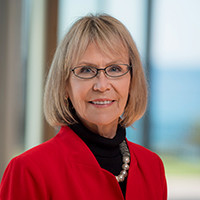
Thank you to all of the Scripps Institution of Oceanography supporters, staff, students, postdoctoral scholars, researchers, faculty, and alumni who helped make 2023 an incredibly impactful year. Those impacts occurred at many levels. Scripps scientists’ research provided essential information for those managing risks associated with climate change, ocean and coastal hazards, as well as geological risks. This includes delivering information to policymakers working on legislation for our region, the State of California and the nation. We also contributed perspectives that influenced international agreements like the United Nations Framework Convention on Climate Change and activities like the UN Decade of Ocean Science for Sustainable Development.
As usual, our scientific discoveries had a major impact on our fields and understanding of our planet. Researcher emeritus Peter Bromirski made waves with his findings that the average heights of winter waves along the California coast have increased as climate change has heated up the planet. Polar scientists Tyler Pelle and Jamin Greenbaum found that meltwater flowing out to sea from beneath Antarctic glaciers is making them lose ice faster, a process not currently accounted for in sea-level rise projections.
Our research also helped improve lives and livelihoods. January 2023 on the West Coast started with a deluge of atmospheric rivers that had Scripps scientists working at full steam to deliver forecasts to the public and reservoir operators. The “AR Recon” program (more detail below) is a fantastic example of applying cutting-edge science to save lives, increase water resiliency in a changing climate, and reduce risk of storm hazards.
We also celebrated the inaugural cohort completing the SCUBA DIVERsity Fellowship Program. This program shows the impact our students and alumni can have — the fellowship was the brainchild of former PhD students Alyssa Griffin and Erica Ferrer, made a reality through perseverance and philanthropic support.
And we closed out the year at COP28 in Dubai, where Scripps helped put the ocean on the global stage at the Ocean Pavilion. Our amazing students, faculty and staff met with world leaders to increase attention on the necessity for expanded ocean observations, the potential for blue carbon solutions, and to illuminate the impact of climate change on our ocean.
From within our state to around the globe, I’m immensely proud of how our community continues to make an impact on understanding and protecting our planet.
Margaret Leinen
Vice Chancellor for Marine Sciences, UC San Diego
Director, Scripps Institution of Oceanography
DIRECTOR'S COUNCIL MEMBERS
Prakash Arunkundrum
Maxine Baker
Mary Ann Beyster
Paul Brooks
Julia Brown
Bernard David
Tim Gallaudet
Cynthia Glancy
Stuart Goode
Richard Gulley
Richard Hertzberg
James Jameson
Wayne Kennedy
Donna Lucas
Dennis McGinn
Michael Meredith
Chrysa Mineo
Elizabeth Oliver
Tom Page
John Patton
David Price
William Revelle
John Richardson
William Scripps Jr.
Michael Silah
Dixon Smith
Mike Stone
Steve Strachan
Joseph Tell
Craig Venter
Caroline Winn
Dawn Wright
Research Highlights
Chasing Atmospheric Rivers to Improve Forecasts and Water Supply Reliability
The 2022-2023 rainy season was one for the record books in California. Seven atmospheric rivers classified as "strong" or greater dumped rain and snow on California during the 2022-2023 rainy season, with 46 total atmospheric rivers making landfall along the U.S. West Coast, lifting the majority of the state out of drought conditions and causing disastrous flooding.
Improvements in studying and forecasting atmospheric rivers have been led by the Center for Western Weather and Water Extremes (CW3E), particularly via their Atmospheric River Reconnaissance (AR Recon) program. This program brings together the U.S. Army Corps of Engineers, the California Dept. of Water Resources, NOAA Office of Marine and Aviation Operations, and the U.S. Air Force Reserve 53rd Weather Reconnaissance Squadron “Hurricane Hunters” to intercept atmospheric river storms to collect data that improves forecasts.
In Water Year 2022-2023, the AR Recon program orchestrated 51 NOAA and Air Force “Hurricane Hunter” flights, successfully deploying 1,380 dropsondes over atmospheric river storms in the North Pacific. The data collected from these flights is incorporated in real-time into global forecast models, and is invaluable to flood control managers, water supply authorities, and reservoir operators, who use the updated forecasts to prepare for and mitigate flooding or take advantage of the water supplied by atmospheric rivers.
These improved forecasts are leading to increased water supply reliability, with reports showing up to 20% more water capable of being stored at Lake Mendocino in Sonoma County, and the capability of up to 23,000 acre-feet of additional groundwater recharge at Southern California’s Prado Dam, which is enough water for over 180,000 people per year.
“Climate models suggest atmospheric rivers are only going to become more important as hazards and as water sources, making efforts like ours to better forecast and understand them an essential facet of adapting to our world’s changing climate,” said Marty Ralph, founding director of CW3E.
Read more on CW3E’s Atmospheric River Reconnaissance Program.
California’s Salton Sea Staving Off Earthquakes
New research finds that as the Salton Sea in Southern California has dried up, it has stabilized the southern section of the San Andreas Fault, perhaps delaying the next “big one.” This section of the fault poses the largest seismic hazard in all of California because of the damage a significant earthquake could cause to the populous Los Angeles metropolitan area.
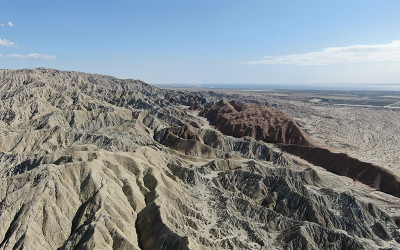
For the last 1,000 years or so, the southern San Andreas Fault went around 180 years between major earthquakes, but it’s now been more than 300 years. Yuri Fialko, the study’s co-author and professor of geophysics at Scripps, described the southern San Andreas as “locked and loaded” for a big shake that could cause an estimated 1,800 deaths and $200 billion in damage if it strikes at a magnitude of 7.8.
Using computer modeling, the research team found that when the Salton Sea basin filled with water to form the prehistoric Lake Cahuilla, its weight bent the surrounding crust and its water penetrated deep underground, each of which altered the forces acting on the fault in ways that could help trigger a massive rupture and severe shaking.
The research, funded by the Southern California Earthquake Center, National Science Foundation, NASA, and the U.S. Geological Survey, suggests that the relationship between big-time seismic activity and the filling of the Salton Sea basin may also help explain why the southern section of the San Andreas Fault is long overdue for its next major shakeup.
Read more on this collaborative research with San Diego State University.
Scientists Awarded Funding to Develop Model to Predict Pathogens in Imperial Beach
For decades, California’s southernmost coastline has been ravaged by discharges of trash, sediment and wastewater, including dangerous pathogens and chemicals flowing up from Mexico and through the Tijuana River. In August 2023, the state of California awarded Scripps Oceanography $3 million to develop a model to forecast the presence of pathogens in San Diego's coastal and tidal waters.
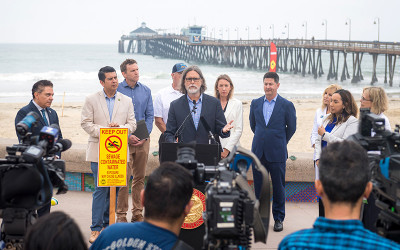
The Tijuana River Estuary and Coastal Ocean Pathogen Forecast Model aims to predict the presence of bacterial and viral pathogens from untreated sewage in estuary and coastal waters, which can inform decision-makers when beach closures are necessary as the region works to address cross-border sewage pollution.
The project will involve an interdisciplinary team of biological and physical oceanographers working together to develop the estuary and coastal ocean pathogen forecast model. Scientists at Scripps have already developed a physical model showing how ocean and estuary currents and contaminated wastewater are transported along the coast. This three-year program aims to expand to include pathogen modeling, data assimilation and forecast capabilities in real-time.
The program will also fund regular and event-based water sampling at beach and coastal locations to pinpoint the types of pathogens in the water and their abundance.
“I’ve been studying pollution transport in the border ocean region for 15 years and seen and experienced the impacts of untreated sewage in the ocean firsthand,” said Falk Feddersen, a physical oceanographer at Scripps. “We are very excited to develop this pathogen forecast model that will provide information to residents and tourists and reduce human health risks on both sides of the border.”
Read more on this pathogen forecast model here.
ALERTCalifornia AI Fire Detection Program TIME Magazine Invention of the Year
Expanding beyond wildfire camera technology, in 2023 ALERTCalifornia collaborated with CAL FIRE to create a new artificial intelligence tool with the goal of improving firefighting capabilities and response times. The tool has proven so effective, TIME magazine named it one of the best inventions of 2023. The annual list features 200 extraordinary inventions that change lives.
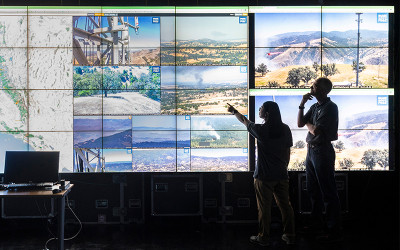
When AI spots a potential fire on ALERTCalifornia’s network of more than 1,060 cameras, the system alerts firefighters and provides a percentage of certainty and estimated location for the incident. If the incident is vetted and confirmed by trained watchstanders, firefighters respond quickly to extinguish the fire at the incipient phase.
The AI tool — developed by UC San Diego researchers, CAL FIRE and Digital Path — became available to all 21 CAL FIRE 911 Dispatch Centers in September 2023. This new tool is especially effective in spotting anomalies in remote locations and is proven effective at night, even alerting firefighters before 911 calls.
“CAL FIRE remains resolute in our mission to protect the people and natural resources of California, and our collaboration with ALERTCalifornia is a testament to our relentless pursuit of innovative solutions. Together, we are shaping a safer and more secure future for our state,” said CAL FIRE Director and Fire Chief Joe Tyler.
ALERTCalifornia is a public safety program comprised of a multidisciplinary team based at Scripps Institution of Oceanography, Jacobs School of Engineering, and the Qualcomm Institute.
Estuary Experiment Makes Waves… Pink Ones
Months before Barbiemania captivated global moviegoing audiences, an experiment led by coastal physical oceanographers at Scripps made waves worldwide for dyeing the ocean Barbie-hued pink. The experiment, led by Sarah Giddings and titled Plumes in Nearshore Conditions, or PiNC, took place in January and February 2023 with the goal of learning more about how small freshwater outflows from estuaries interact with the ocean’s surfzone.
To do this, scientists released an environmentally safe pink dye in the mouth of the Los Peñasquitos Lagoon, located within Torrey Pines State Beach and Natural Reserve in San Diego, Calif. The team then tracked the fluorescent pink dye from land, sea, and sky using a variety of instruments including drones, sensors affixed to poles in the sand in the river mouth and surfzone, jet skis, moorings and sensors deployed along the seafloor and more.
The experiment is providing the first-ever view of the buoyant plume/wave mixing dynamics at play in this particular location and will lead to an improved understanding of how other small estuaries interact with the waves at locations around the globe. This provides crucial data for quantifying the spread of sediment, pollutants, larvae, and other material in the nearshore environment.
Learn more about this National Science Foundation-supported experiment.
BIRCH AQUARIUM
Securing the Future of Seadragons
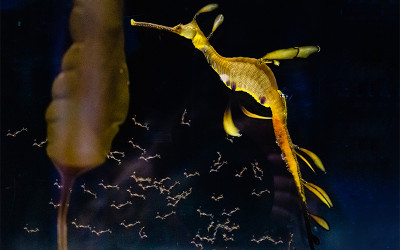
A leader in seadragon care and conservation, Birch Aquarium has been studying the secrets of seadragons both in the wild and at the aquarium for more than two decades. This year the aquarium welcomed a bounty of baby Weedy Seadragons, an incredible feat only a handful of facilities have accomplished.
This monumental milestone also marked the first time in aquarium history that eggs were transferred in the Seadragons & Seahorses habitat. Like seahorses, seadragon males — not females — are responsible for carrying eggs. An egg transfer is quick and occurs only after the seadragons participate in an elaborate courtship.
The hope is that captive breeding programs will lead to fewer seadragons being collected from their native habitat, which is already under increasing pressure due to climate change.
Saving the Critically Endangered Sunflower Star
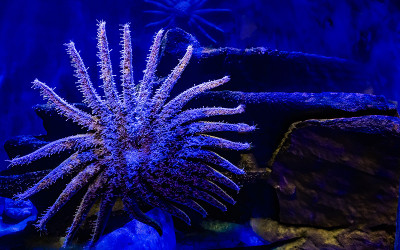
A mysterious Sea Star Wasting Disease has swept across the West Coast for almost a decade, causing a mass die-off of sea stars particularly in warming waters. It hit Sunflower Sea Stars the hardest, nearly driving them to extinction. However, hope is on the horizon for the critically endangered Sunflower Sea Star thanks to a groundbreaking collaborative effort among accredited aquariums, zoos and research laboratories.
In October, Birch Aquarium successfully spawned three male Sunflower Stars, the latest success in a collaborative effort to help reproduce and eventually reestablish populations on the West Coast. The aquarium shared this genetic material with numerous organizations to increase the genetic diversity of Sunflower Star populations with the long-term goal of reproducing and eventually reestablishing populations on the West Coast.
Birch Aquarium Numbers Fiscal Year '22-'23
523,703 total attendance (all-time record)
366 schools served
41,000 total students served
22,000+ students received financial aid
$375,000 total scholarship dollars given (all-time record!)
Equity, Diversity and inclusion
Scripps Partners with Bridge Builders Foundation to
Expose Youth of Color to Opportunities in Higher Education
In August 2023, the Bridge Builders Foundation visited Scripps for the second year as part of the foundation’s marine science program for high school students. This program at Scripps is designed to help bridge the socioeconomic gap in STEM education by exposing youth of color to a broad range of possibilities in higher education.
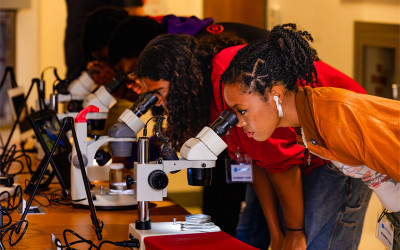
Bridge Builders is a nonprofit organization based out of Los Angeles that seeks to remove barriers of race, poverty, ignorance and despair through youth mentoring and educational support.
“This partnership with Bridge Builders highlights the inclusive and immersive experiences Scripps, Birch Aquarium and UC San Diego are committed to providing as a means of increasing access to science and education in ways that are culturally relevant and impactful for communities of color,” said Scripps Director of Diversity Initiatives Keiara Auzenne.
Students stayed in UC San Diego dorms, participated in activities related to Scripps science and research, and learned about academic and science career opportunities directly from professionals at Scripps and NOAA. Youth gained insight into research and careers in earth, ocean and atmospheric sciences, as well as into the college student experience.
Learn more about the Bridge Builders and Scripps partnership.
First Cohort Completes the Scripps SCUBA DIVERsity Fellowship Program
The first cohort of seven students completed the Scripps SCUBA DIVERsity Fellowship Program and received their scientific diver certification.
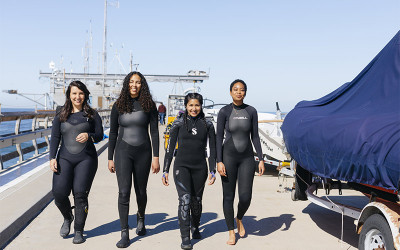
To make the diving community a more inclusive and diverse space, then-PhD candidates Erica Ferrer and Alyssa Griffin launched the SCUBA DIVERsity Fellowship Program at Scripps in the fall of 2022 with support from Scripps Director of Diversity Initiatives Keiara Auzenne and Dive Safety Officer Christian McDonald. Students in the program receive access to scientific diver training, SCUBA gear, mentorship and swimming proficiency lessons for those who have limited experience in the water.
This program promotes Scripps’ efforts to educate and respond to the needs of a diverse and dynamic student body and also opens doors for future scientists of color and those from underrepresented groups to gain access to research opportunities where diver certification often presents an insurmountable barrier.
“As a mentor, it has been incredible to see the first cohort of fellows become divers and help to build a sense of community within the program,” said Ferrer. “Seeing the fellows excel in the diving community reminds me why we created this program in the first place and why we will continue creating opportunities for future generations of students over the years.”
SCUBA training for the second cohort is currently underway. Learn more about the SCUBA DIVERsity Fellowship Program and meet the first cohort in this story.
SCRIPPS INSTITUTION OF OCEANOGRAPHY RESEARCH VESSELS
California Coastal Hydrogen-Hybrid Vessel Design Advances
Earlier this year, California Governor Gavin Newsom and Senate President Pro Tempore Toni G. Atkins stopped by UC San Diego’s Nimitz Marine Facility to learn about progress on Scripps’ innovative new California Coastal Research Vessel (CCRV) in development. The vessel is being designed with a hydrogen-hybrid propulsion system that will enable it to operate with zero-emission capabilities, a first-of-its-kind system in the maritime industry.
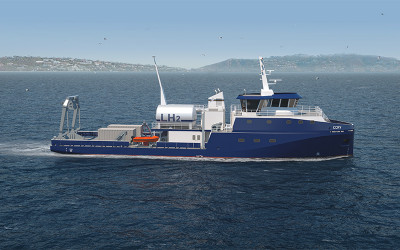
As naval architect Glosten finalizes the design, other key equipment suppliers came into place this year with Ballard Power Systems selected to provide the fuel cells that will power the vessel, and Chart Industries selected for the cryogenic tank and gas system that will supply liquid hydrogen to the fuel cells — both essential components of a hydrogen-fuel-cell propulsion system. CCRV will be the first liquid hydrogen-powered ship in America, requiring an entirely new regulatory framework, and we have made important progress with the U.S. Coast Guard and the classification society (American Bureau of Shipping) to establish the technical standards for the construction and operation of hydrogen-powered ships, which will be precedent-setting.
Additionally, in October, the Department of Energy (DOE) chose California as one of seven hydrogen hubs, regions where the agency will fund coordinated networks of hydrogen fuel producers, purveyors and consumers. A University of California-backed consortium called the Alliance for Renewable Clean Hydrogen Energy Systems, or ARCHES, managed the state’s application to DOE, and will steer up to $1.2 billion in federal funding toward 39 hydrogen infrastructure projects up and down the state, including CCRV, a Tier 1 marquee project.
“We are proud to be part of ARCHES, and part of California’s transition away from fossil fuels and towards a clean, sustainable energy ecosystem,” said Bruce Appelgate, Scripps Oceanography’s Associate Director and head of ship operations. “Hydrogen is an essential element in the hard-to-decarbonize maritime industry, and ARCHES is providing the platform to leverage DOE funding to create an economically-sustainable hydrogen network here. Our involvement with ARCHES enables us to fulfill the Scripps mission of taking students to sea and giving them their first-ever experience on the water, and with CCRV, we’ll do that using an inspirational, zero-emission vessel.”
Ship Tracks
During the calendar year 2023, Scripps oceanographic research vessels carried 1,239 people to sea on 64 separate research missions, spending 669 operational days at sea conducting scientific research and instruction. Of the people who sailed aboard, 516 were from Scripps, and the remaining came from 119 different institutions.
GIVING IMPACT
Scripps Brings Ocean Science to COP28
The University of California is an observer organization accredited by the United Nations Framework Convention on Climate Change (UNFCCC), which for many years has enabled Scripps Oceanography to attend and participate in the world’s most influential climate change conference, known as Conference of Parties, or COP.
In 2023, UC San Diego sent a delegation of nearly 30 students, staff and faculty to COP28 in Dubai, United Arab Emirates. For the second year, Scripps Oceanography co-organized the Ocean Pavilion, a space which brings together world leaders in ocean science, engineering, policy and philanthropy to highlight the ocean’s critical role in offering climate solutions, and raise awareness of the ocean’s influence on climate. The COP28 student delegation and Ocean Pavilion is generously supported by Logitech and others. Logitech is a global technology and design company committed to sustainable practices. This support ensures the Scripps Oceanography delegation is able to participate, inform and engage in these important global discussions.
Scripps and Ocean Pavilion co-organizers Woods Hole Oceanographic Institution also spearheaded the creation of the Dubai Ocean Declaration to emphasize the need for ocean science and call on climate negotiators to prioritize observations as critical for understanding ongoing global climate changes. The declaration was signed by more than 120 global organizations, including The Vatican.
Biomedical Automation Facility in Development
Advances in biomedical technology now make it possible for society to benefit from marine life without harming fragile ecosystems, utilizing the unique properties of marine compounds for pharmaceutical applications. Scripps Oceanography has played a pioneering role in developing drugs from the sea, resulting in the development of new therapeutics for treating many human diseases, including the brain cancer glioblastoma.
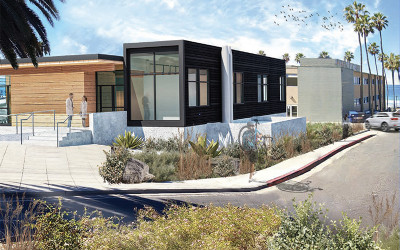
Now thanks to two significant contributions, Scripps is on its way to constructing a scientific facility that will level up the capacity to identify and develop new compounds for clinical testing. Genetic sequencing equipment donated in-kind by Illumina will provide the scientific horsepower for experimentation, while a generous philanthropic commitment kicks off fundraising for a remarkable facility to house this equipment and integrate scientific activities into a seamless, automated workflow.
The proposed Biomedical Automation Facility (BAF) is modeled on resources common in private industry, but rarely found in academia. Genetic sequencing equipment will be leveraged by robotic assemblies preparing and conveying samples rapidly, optimizing access and speeding up the discovery process and helping train the next generation.
For more information on the opportunity to support this groundbreaking new facility, please contact Jini Bernstein Archibald at jbarchibald@ucsd.edu or (858) 395-7799.
Thank you to our donors!
Individuals
$1,000,000+
Cynthia Walk and
Charles H. Wolfinger Jr.
Ellen J. Lehman, PhD and
Charles F. Kennel
Eric W. Wolfinger
$500,000+
Joan K. Jacobs and Irwin M. Jacobs
Walter C. Gutjahr*
$100,000+
April Minnich-Bucksbaum and
Glenn Bucksbaum
Brenda Bohn and
Jeffrey R. Bohn, PhD
Brooke M. and Jonathan L. Scripps
Cindy J. Glancy '77 and
John E. Glancy Sr.
Cythia and George Mitchell
Elizabeth H. and Dene Oliver
Gisela G. Hill
Kathy S. and Philip Froelich
Margaret B. Engel and
David Engel, PhD
Margaret K. and Eaton M. Scripps
Wendy and Eric E. Schmidt
$50,000+
Allison and Robert E.Price
Anonymous
Catherine B. and Matthew Hervey
Celeste and Wendell Birkhofer
Elizabeth M. Scripps
Elizabeth M. and Philip S. Hiestand
James F. Beyster
Kathy and William H. Scripps
Mary G. Jameson and
Larry W. Wangberg
Nancy E. Cooley and
Stuart M. Goode
Stephen M. Strachan
$25,000+
Eve S. and Osama Attal
Gail E. and John H. Eyler Jr.
Jeanne B. Sleeper
Jean W. Scripps
Kristin and Raymundo H. Granado Jr.
Linda U. Hervey
Mary Ann Beyster
Susan M. Engelhorn and
Sheldon C. Engelhorn '72
$10,000+
Alvina Harris
Amy L. and Charles H. Spielman
Anonymous
Betsy F. Mitchell and
Brian G. Mitchell, PhD
Bev Grant
Charles Ellman*
Charlotte Yarkoni
Cheryl L. and Donald L. Ward
Diane I. and Elliot Feuerstein
Donna A. Lee '82
Ellen C. and Colin Kennedy
Ellen Fales
Gina P. Rogers
Jamin S. Greenbaum, PhD
Jane P. Widroe '84 and Greg Widroe
Jordan Tapper
Joyce A. Haak-Brooks and
Paul Brooks
Karen F. and Jeffrey H. Silberman
Kathy and Charles T. Mitchell
Kristina and Semyon Kruglyak
Lesley A. and Michael J. Vines
Lynne D. Talley and
Jeffrey P. Severinghaus
Miranda Ko
Miriam Kastner
Randal D. Vosti
Wendy W. Kwok '99
* planned gift
Foundations
$1,000,000+
Wayne and Gladys Valley Foundation
$500,000+
The National Philanthropic Trust
Vetlesen Foundation
$100,000+
Green Foundation for Earth Sciences
The Jewish Community Foundation
Mark Walk Wolfinger Foundation
Simons Foundation, Inc.
St. Baldrick's Foundation, Inc.
The Heising-Simons Foundation
The JEM Project
The San Diego Foundation
The Schmidt Family Foundation
Waitt Foundation
$50,000+
Dr. Seuss Foundation
Edna Bailey Sussman Fund
Gibbet Hill Foundation
Pincus Family Foundation
Maxwell Hanrahan Foundation
Nierenberg Foundation
The Mary Gard Jameson Foundation
$25,000+
Ellen Browning Scripps Foundation
Price Philanthropies Foundation
The Gordon and Betty Moore
Foundation
The Pacific Blue Foundation
Corporations
$1,000,000+
National Academy of Sciences
The Builders Initiative, Inc.
$500,000+
SDG&E
$100,000+
National Geographic Society
Revive & Restore
State Water Contractors
Sustainable Surf
$50,000+
Canadian Institute for Advanced Research
Hong Kong University of Science
and Technology
Nunatsiavut Government
$25,000+
Blue Ocean Barns Inc.
City of San Diego
Columbia University
Environmental Defense Fund
Illumina Corporate Foundation
JBS & Associates
Jet Propulsion Laboratory
Newlight Technologies, Inc.
Oceans North
Orange County Community
Foundation
Orange County Water District
Salt River Project
San Diego County Water Authority
Santa Clara Valley Water District
Turlock Irrigation District
U.S. Bank Foundation
$10,000+
Arey Jones Educational Solutions
Bluewhite
City and County of San Francisco
City of Seattle
Devine Consulting
Douglas Products
East County Economic
Development Council
Hygeos
Irvine Ranch Water District
Kongsberg Underwater
Technology, Inc.
MathWorks, Inc.
Ocean Visions, Inc.
Qualcomm Inc.
Resilient Cities Catalyst
ResMed Foundation
The Ocean Cleanup
Tokyo Institute Of Technology
View our archive of previous Impact Reports.